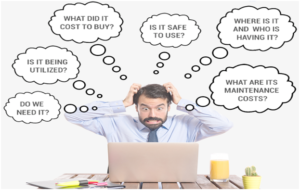Asset management refers to the process of developing, operating. Maintaining, amortization, selling and scrapped assets in a cost-effective manner. Most commonly used in Education, Finance, leasing and manufacturing field. It is an important aspect of asset management and aims to increase business accountability. While reducing the likelihood of assets being neglected, lost, or stolen. It is often implemented as one of the features in asset management solutions. The term is used in reference to individuals or organizations that manage assets on behalf of individuals or other entities. Businesses in various industries need to have a clear picture and records of all their assets. Mainly where they are, who are using and what their status is. Asset management proved to be an efficient, transparent and streamlined process that facilitates this need.

Asset Management
Challenges in assets management
Actually, asset management is challenging various business units in the reality. There are four key challenges as below which is worthy to discuss.
- Most business units have no standard and tables to record its assets and categories. It causes difficulty to make an inventory and reducing its efficiency and accountability. No body know their assets status now?
- There is no regulation and category for assets. It is very difficult to track the assets and take long time to seek for. You cannot find it when demands. It may re-order the same assets. Which caused resource wasted in the inner operation.
- There is no records and alerts for normal maintenance. Mostly reparation instead of maintenance in daily operation. Which cause scrapped in advance?
- However, it may loss, steal or damaged. Because there is no audit to keep them safe.
why do asset management?
Asset management is definitely a topic worth discussing. Every organization needs their products and services to win the markets. That way, its stakeholders, will know which assets are available to be employed to provide optimal returns. The assets owned by any business fall into two main categories: fixed and current assets. Fixed or non-current assets refer to assets acquired for long-term use. While current assets are those that can be converted into cash within a short amount of time. There is important for asset management. There are benefits reasons why businesses should be concerned about asset management, including:
-
Enables an organization to account for all of its assets
Asset Management 2
asset management makes it easy to keep track of their assets. Whether liquid or fixed. the owners will know where assets are located. How to use, and whether there have been changes made to them. Consequently, the recovery of assets can be done more efficiently. Hence, leading to higher ROI (rate of investment).
-
Helps guarantee the accuracy of amortization rates
Since assets are checked on a regular basis, the process ensures that the financial statements record them properly.
-
Helps identify and manage risks
Asset management encompasses the identification and management of risks that arise from the utilization and ownership of certain assets. It means that the business unit will always be prepared to manage any risk that comes its way.
- Removes ghost assets in the company’s inventory
Instances exist where lost, damaged, or stolen assets are incorrectly recorded on the tables. With a strategic asset management plan. The owners will be aware of the assets that have been lost and will eliminate them in the tables.
Solution for management
When it comes to asset management, the manager will consider how to make a lifecycle asset management plan and solution. There are some frames for owner to reference.
-
Asset Management 3
Create the category and fill into the tabs
To make a list for all asset in the tabs. All the asset will keep its records how to get, date of getting,value,category,maintenance way,etc. All this original data must be filled in the asset tabs for records and create the code for this asset. Which is a unique code and traceable.
The process will be recorded in tabs for all assets. Including its location, the status of renting and scrapped, etc activity is trackable and transparency. In a word, there is the entire lifecycle management for assets. You can track all its activity from its unique code.
-
Daily maintenance
The process is doing according to the rule of asset maintenance. Which can improve its lifecycle and accountability. Meanwhile, it reduce its losses in amortization and scrapped.
-
Daily audit
There is a unique code for each asset to track all activity. Which help the manager of assets management to check its real situation. It’s easy to make an inventory for all assets. To reduce its stolen, lost and damaged possibility.
Before choosing the right solution. The owner need to know the difference of barcode label, RFID tags and active tags(battery powered tags).














